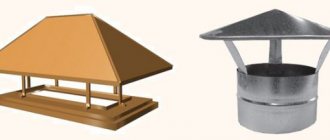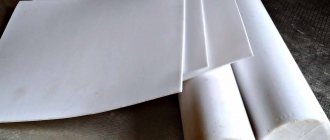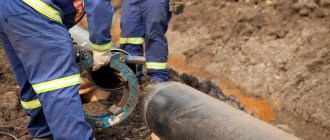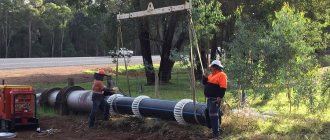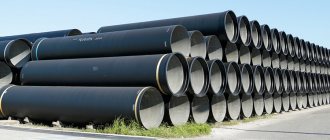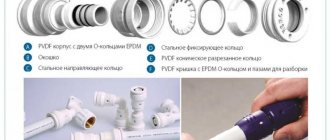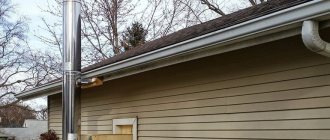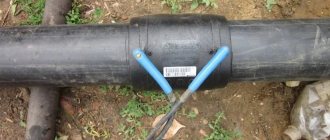Two types of pipes
An affordable option for asbestos-cement pipes is made from amphibole mineral. This material is bad for human health and can lead to malignant tumors in the respiratory tract. Therefore, it is practically not used anywhere. The chrysolite composition of pipes is considered less harmful. It is not so toxic, but is not completely broken down in the lungs.
All pressure and non-pressure drainage systems are equipped with asbestos-cement pipes. They are durable and resistant to high temperatures. The asbestos-cement composition prevents moisture from seeping through the pipe walls.
For the drainage system, it is necessary to select the correct diameter of asbestos-cement pipes, and also take into account the following:
- Wall strength;
- Pipe type for pressure or non-pressure system.
Pipe installation is carried out using rubber couplings or seals.
How to choose the right chimney?
This material is quite cheap, so it’s better not to look for even cheaper ones, since such pipes can crack during transportation. You need to buy pipes only from trusted places where they can provide quality guarantees.
What you need to do before purchasing:
- It is necessary to inspect the pipes for cracks, chips and foreign inclusions.
- Make sure that the pipe is level with uniform wall thickness.
- Be sure to purchase asbestos cord to seal the joints.
- Make sure that the cross-section of the pipe matches the diameter of the boiler pipe.
Typically, the diameter of asbestos pipes ranges from 10 to 50 cm, so choosing the right one for the boiler will not be so difficult. To reduce the number of joints in the chimney, a 5 meter pipe is usually used. If such a length would interfere with transportation, there are also 3 meter pipes.
To connect the asbestos pipe to the boiler pipe, it is recommended to use a special adapter or a stainless steel gas outlet pipe. Such a connection will ensure tightness.
Non-pressure pipe option
Non-pressure asbestos-cement pipes have a fairly wide range of applications:
- Design of a non-pressure water supply system;
- Sewerage installation;
- Construction of waste chutes in multi-storey buildings;
- Installation of chimneys and ventilation systems;
- Construction of drainage canals;
- Drainage systems, etc.
For agriculture, chrysotile cement pipes are used to construct irrigation and reclamation canals.
Asbestos-cement pipes - assortment
Asbestos-cement pipes and couplings are divided into pressure water pipes (GOST 539-59) and non-pressure sewer pipes (GOST 1839-48).
Water pipes, depending on their purpose, are divided into four brands:
VTZ - for a working hydraulic pressure of 3 atm
Table of contents items not found. Dimensions of water supply asbestos-cement pipes (in mm)
Table 127
| conditional pass | Inner diameter | Outer diameter of machined ends | Pipe length | Reference pipe weight in kg | Coupling inner diameter | Reference weight of coupling in kg | ||||||||
| VTZ,VT6, VT9 | VT12 | VT3 | VT6 | VT9 VT12 | VTZ | VT6 | BT9 | VT12 | VM3 | BM6 | VM3 | BM6 | ||
| 50 | 50 | – | 68 | 68 | 68 | – | 11 | 11 | 11 | – | 79 | 79 | 1,2 | 1,2 |
| 75 | 75 | — | 93 | 93 | 93 | 2950 | 16 | 16 | 18 | — | 104 | 104 | 1.5 | 1,5 |
| 100 | 100 | — | 118 | 118 | 122 | – | 21 | 21 | 25 | — | 130,6 | 130,6 | 1,9 | 1,9 |
| 125 | 119 | — | 137 | 139 | 142 | 2950 | 24 33 | 26 35 | 31 41 | 48,5 | 149,6 | 151,6 | 2,1 | 2,3 |
| 150 | 141 | 135 | 161 | 163 | 168 | 3950 | 32 43 | 35 47 | 43 57 | 50 67 | 173,6 | 175,6 | 2,7 | 2,9 |
| 200 | 189 | 181 | 209 | 217 | 224 | – | 57 | 80 | 95 | 118 | 221,1 | 229,1 | 3,3 | 4,4 |
| 250 | 235 | 22 6 | 259 | 265 | 274 | – | 86 | 106 | 134 | 152 | 271,1 | 277,1 | 4,4 | 5,4 |
| 300 | 279 | 270 | 305 | 314 | 324 | 3950 | 142 | 146 | 188 | 218 | 317,1 | 326,1 | 5,0 | 6,8 |
| 350 | 322 | 012 | 352 | 361 | 373 | – | 145 | 184 | 238 | 278 | 366,2 | 375,2 | 7,3 | 9,1 |
| 400 | 368 | 356 | 4?’2 | 414 | 427 | – | 185 | 245 | 315 | 317,5 | 416,2 | 428,2 | 9,5 | 12,1 |
| 500 | 456 | 441 | 498 | 511 | 528 | – | 279 | 364 | 4ЪЪ | 549 | 512,2 | 525,2 | 16,1 | 20,0 |
To connect VTZ and VT6 pipes, asbestos-cement couplings of the VMZ and VM6 brands are used, respectively; Cast iron couplings are used to connect pipes V G9 and VT12.
By agreement between the consumer and the plant, pipes of the VTZ and VT6 brands with a nominal bore of 600, 700, 800, 900 and 1000 mm with cylindrical asbestos-cement couplings for caulking can be manufactured according to the agreed technical specifications.
Table 128 - Dimensions of asbestos-cement sewer pipes (in mm)
| Conditional pass | Inner diameter | Outer diameter and tolerances | Length and tolerances | Reference weight of one pipe in kg | Reference weight of one coupling in kg | Coupling inner diameter |
| 100 | 100 | 116 +2-2,5 | – | 14,7 | 1,61 | 145 |
| 125 | 123 | 139 +2-2,5 | 2950 -50 | 18,5 | 1,87 | 171 |
| 150 | 147 | 165 +2-2,5 | – | 25,9 | 2,53 | 190 |
| 200 | 195 | 215 +2-2,5 | – | 51,0 | 3,30 | 245 |
| 250 | 243 | 265 +2-2,5 | – | 69,0 | 4,20 | 295 |
| 300 | 291 | 315 +2.5-3 | – | 90,2 | 5,30 | 345 |
| 350 | 338 | 364 +2.5-3 | 3925-50 | 113,8 | 6,45 | 390 |
| 400 | 386 | 414 +2.5-3 | – | 138,2 | 9,25 | 460 |
| 500 | 482 | 514 +2.5-3 | – | 196,0 | 12,60 | 550 |
| 600 | 576 | 612 +2.5-3 | – | 272,4 | 18,40 | 632 |
Asbestos-cement pipes and couplings are tested for the following hydraulic pressure:
VTZ pipes and VMZ couplings - 8 atm VT6. VM6-12, VT9-18, VT12-24.
Sewer regardless of diameter 4 atm.
In addition to their main purpose, water pipes can be used for oil pipelines, for district heating with an operating pressure of up to 5 atm at temperatures up to 80°, for gas pipelines with a gas pressure of no more than 5 atm and for sewerage.
Sewage pipes are used for internal and external free-flow sewage of fecal water, as well as for drainpipes, garbage chutes, ventilation ducts, chimneys and telephone pipelines.
The inner surface of pipes used for home sewage must be covered with a waterproof layer (bitumen, etc.).
Pipe sizes and characteristics
The length of pressure hollow pipes starts from 3.95 m and reaches 5 m. The cross-section of asbestos-cement pipes can be different, it all depends on the type of construction:
- 100-150 mm – ventilation systems and water supply;
- 200-250 mm – used for the construction of a network line;
- 300 mm is the optimal diameter for drainage systems;
- 400 mm – used in the construction of large water pipelines;
- 500 mm – used in production.
Read here: Review of the best waterproofing materials: how to choose the right modern polymer mastics
Large diameter products are not produced because this is a technically complex process. There are certain GOST standards for asbestos-cement pipes that prevent low-quality products from entering the markets.
Advantages and disadvantages
Of course, like any other structure, asbestos products have their advantages and disadvantages. Some of the advantages include:
- its low cost - the design is quite simple, you can quickly build it yourself;
- Another small plus is that an asbestos chimney will be much lighter than a metal one.
At the same time, such a channel has a number of disadvantages. You should definitely pay attention to them, as this will help to correctly assess all the operating conditions of the chimney, and decide whether it is suitable at all. So:
- The main disadvantage, which, by the way, is often forgotten, is the low output temperature. Such pipes are suitable only for low-power gas boilers. In no case should they be used to remove combustion products of solid fuel, because the temperature there is simply enormous, and this can lead to the destruction of the chimney or even a more serious accident.
- Another drawback is that the material has no heat capacity, resulting in weak traction.
- To avoid condensation, the pipe will have to be sufficiently well insulated at the junction with the roof.
- When installing the structure, it is not possible to install inspection hatches, and this, in turn, threatens the appearance of soot, which will then be impossible to clean.
- This type of pipe can only be installed vertically.
- If the standards are violated, there is a high level of fire hazard.
Characteristics of pressure pipes
The main feature of pressure asbestos-cement products is their ability to withstand high water pressure. They can be used in the construction of heating mains, sewers, and water supply systems. They are also used in the ventilation system and in the construction of collectors.
Characteristic requirements for pressure pipes:
- The quality of the product is determined by the conical ends of the pipes;
- Mandatory tests for resistance to high pressure, the product must not allow water to pass through;
- The kit must include mounting couplings.
Positive qualities of asbestos products
Despite the simplicity of the materials used, the pipes have not only a good margin of safety, but also the following qualities:
- Frost-resistant properties;
- Pipes are durable in use;
- The hydraulic resistance is quite small;
- The material is not destroyed by chemical exposure;
- The product can withstand temperatures up to 300 degrees;
- Pipe installation can take place in open ground;
- Affordable prices for all types of products;
- Asbestos pipes are not vulnerable to corrosion;
- Relatively light weight;
- The pipes are conveniently joined and connected by a coupling;
- Manufactured in different sizes.
Installation
Before starting work, measurements are taken, diagrams and calculations of building materials are drawn up. It should be taken into account that ASB sections can only be installed on low-power devices. If a coal furnace is being installed, then they can be attached to heat-resistant products where the exhaust temperature becomes below the maximum permissible.
To assemble a chimney from an asbestos pipe with your own hands, you will need:
- purlins of the required section and length;
- special tees for arranging an audit;
- metal clamp for attaching the channel to the supporting structures of the building;
- galvanized sheet;
- roll insulation;
- roulette;
- Bulgarian;
- level;
- perforator;
- screwdriver;
- hammer;
- metal scissors;
- riveter;
- marker.
Installation of the chimney is carried out according to the following method:
- Attaching the adapter to the pipe (it is advisable to choose a product with smooth transitions). Assembling a support from bricks.
- Installation of heat-resistant sections made of ceramic or metal. Fastening them to the walls with clamps.
- Attaching the adapter coupling. Attaching a link made of asbestos cement.
- Assembling the passage through the floor slab and roof. It is recommended to use a thin slab of lean concrete, which has low thermal conductivity.
- Sealing joints between links.
The final stage is trimming the last run and installing an umbrella on it to protect it from debris and precipitation.
